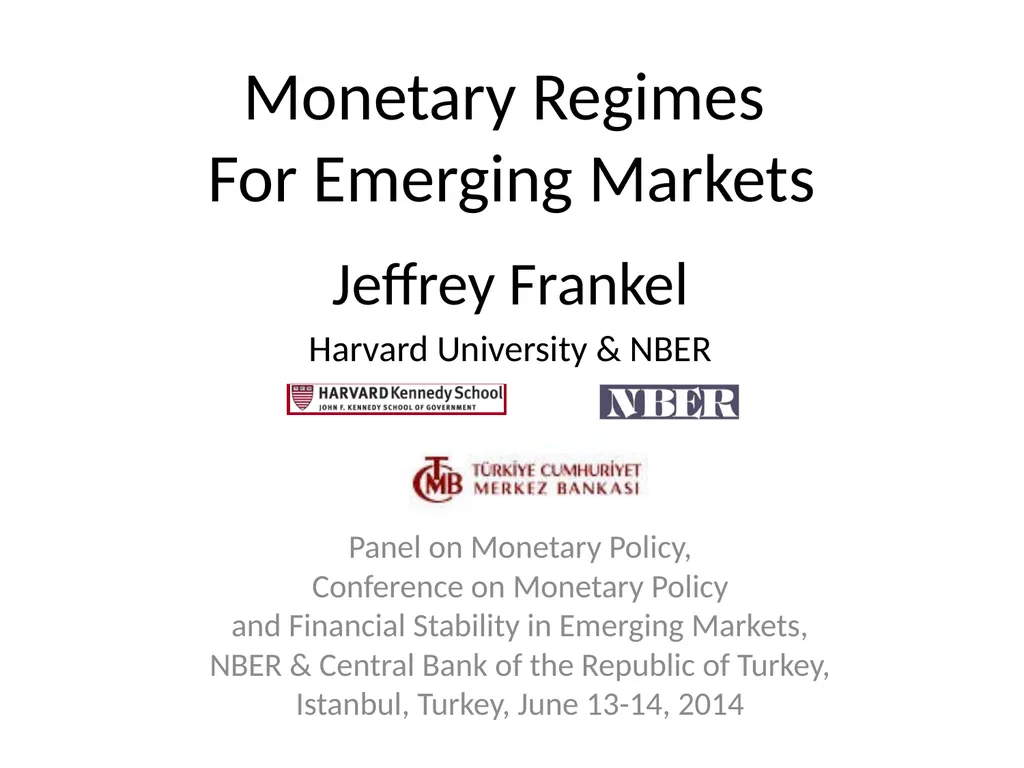Monetary Regimes For Emerging Markets Panel on
Author : luanne-stotts | Published Date : 2025-11-08
Description: Monetary Regimes For Emerging Markets Panel on Monetary Policy Conference on Monetary Policy and Financial Stability in Emerging Markets NBER Central Bank of the Republic of Turkey Istanbul Turkey June 1314 2014 Jeffrey Frankel
Presentation Embed Code
Download Presentation
Download
Presentation The PPT/PDF document
"Monetary Regimes For Emerging Markets Panel on" is the property of its rightful owner.
Permission is granted to download and print the materials on this website for personal, non-commercial use only,
and to display it on your personal computer provided you do not modify the materials and that you retain all
copyright notices contained in the materials. By downloading content from our website, you accept the terms of
this agreement.
Transcript:Monetary Regimes For Emerging Markets Panel on:
Monetary Regimes For Emerging Markets Panel on Monetary Policy, Conference on Monetary Policy and Financial Stability in Emerging Markets, NBER & Central Bank of the Republic of Turkey, Istanbul, Turkey, June 13-14, 2014 Jeffrey Frankel Harvard University & NBER Instruments & Goals 3 Instruments Monetary policy: interest rate Foreign exchange intervention Macro-prudential regulation. 3 Goals External balance: balance of payments Internal balance: price & output stability Financial stability. Macro-prudential regulation A neat “assignment” would let prudential regulation deal with financial stability and let monetary policy deal solely with the macro-economy. But this is too constraining: both policies should address both issues: 1) “Prudential” should be “macro”, not just micro: Counter-cyclical. E.g., loan-to-value ratios should be tighter during overheating than after a crash. 2) CBs should also pay attention to financial stability, beyond if prudential regulation. A CB governor can say “housing prices look high to me.” Can tighten requirements: loan/value ratio, reserves, margins… Ultimately, if needed, can follow up by tightening monetary policy. The Choice of Monetary Regimes for Emerging Markets How are EMs structurally different from Advanced Economies? Choice of exchange rate regime Alternative anchors for monetary policy I. How are EMs different from Advanced Economies? Monetary policy-maker has more need for credibility a) due to high-inflation histories, b) absence of credible institutions, c) or political pressure to monetize big budget deficits. Economy is more exposed to supply shocks a) such as natural disasters, b) other weather events, c) strikes and social unrest, d) productivity shocks. More exposed to terms of trade shocks because country tends to be price-taker Volatility in price of export commodity on world markets Volatility in price of imports like oil on world markets. Trade & Supply Shocks are More Common in Emerging Markets & Low-Income Countries IMF SPRD & World Bank PREM, 2011, “Managing Volatility in Low-Income Countries: The Role and Potential for Contingent Financial Instruments,” approved by R.Moghadam & O.Canuto II. What is the desirable exchange rate regime? Very small, very open, economies will continue to want to fix their exchange rates, in most cases. Most countries are in between, particularly middle-sized middle-income countries. Most of these countries should have intermediate exchange rate regimes, neither firm fixing nor free floating. They include band & basket arrangements. Distribution of EM exchange rate regimes Atish Ghosh, Jonathan Ostry & Mahvash Qureshi, 2013, “Exchange Rate Management and Crisis Susceptibility: A Reassessment,” IMF ARC , Nov.. The













